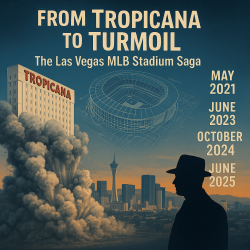⚾ From Tropicana to Turmoil: The Las Vegas MLB Stadium Saga

I still remember the afternoon I stood on Las Vegas Boulevard, the sun beating down as the Tropicana casino came down in a cloud of dust and thunderous applause. It felt like watching history implode—and in many ways, it was the prologue to a saga nobody saw coming.
Dreaming Big on the Strip
Back in May 2021, when MLB quietly told the Oakland A’s they could explore moving, I was covering spring training in Scottsdale. The buzz around relocating to Las Vegas felt like idle chatter—until it wasn’t. Shortly after, I grabbed coffee with my friend Marcus—an urban planner who believed baseball on the Strip could transform the city’s identity. He sketched out early renderings on a napkin: 33,000 seats, a retractable roof to tame the desert heat, and a Jumbotron so big it would rival the Bellagio fountains. At the time, it was a daydream.
Lawmakers, Lawsuits, and Leverage
Fast-forward to June 2023: Senate Bill 1 passed, greenlighting $380 million in taxpayer support for the new ballpark on the Tropicana site, plus a promise to funnel $2 million a year into the community. I sat through the legislative session—sweat beading on the back of my neck—and watched lawmakers debate fiercely. By then, my colleague Sarah had started a podcast called Diamonds in the Desert, interviewing educators worried that schools were getting shortchanged. “We love baseball,” said Dawn Etcheverry of the Schools Over Stadiums PAC, “but not at the expense of our kids’ futures.”
Dust, Drama, and the Devil in the Details
October 2024’s implosion of the Tropicana was cinematic: crowds chanting “A’s on three!” as walls crumbled. I’d spent the morning with Jessica, a lifelong A’s fan who flew in from Oakland for the show. She laughed, tears in her eyes, imagining triple plays in the arena where crooners once sang. Yet beneath the excitement, the project’s wheels were already wobbling.
In March 2025, final stadium renderings dropped—and they were stunning. I shared them with my neighbor, Carlos, who joked that he’d never buy a roof ticket to a Vegas game; “It’s either too hot or raining cocktail umbrellas!” But everyone agreed the design was ambitious.
The Groundbreaking… and the Grind Stop
June 23, 2025, should have been all smiles: MLB Commissioner Rob Manfred, Governor Joe Lombardo, and owner John Fisher posed with golden shovels. I watched from behind the ropes, scribbling in my notebook, while behind me, a group of local vendors handed out mini baseball caps. We thought construction was well underway—but three days later, the unthinkable happened: work halted.
A routine audit uncovered that an unvetted subcontractor—later linked to a federal probe into organized crime—had poured the stadium’s first concrete footing. I spoke off-record with an insider who described the scene: “It was chaos. Suddenly every spotlight turned from the field to the back office.”
Vegas’ Shadowed Past Meets Its Stadium Future
Since its neon birth, Las Vegas has wrestled with its origins—gambling, showgirls, and yes, mob ties. That history whispered through the city’s canyons again when the FBI quietly opened a parallel inquiry. A retired gaming regulator I connected with told me, “It’s a reminder: if your vetting isn’t airtight, old ghosts can come back to haunt you.” Meanwhile, the Nevada Gaming Control Board, always vigilant when casinos—and now a stadium—spring up, is watching every move.
Politics, Pocketbooks, and Public Trust
Around town, conversations crackle with tension. Teachers worry the $380 million could patch leaky roofs in schools; civic activists vow to renew a 2026 ballot challenge. Meanwhile, John Fisher is reportedly eyeing a sale of his San Jose Earthquakes to shore up his $1.1 billion share. My colleague Priya, crunching numbers in our newsroom, described it as a “financial ballet on a very thin wire.”
Stakes High on the Strip
Beyond baseball, this ballpark is the linchpin of a grander vision: resorts, retail, entertainment—all woven into nine acres of what was once Tropicana turf. Urban economist Dr. Lena Morales told me, “Pull this off, and you reinvent the Strip. Screw it up, and it’s a cautionary tale.” I felt that tension firsthand last week, stuck in traffic near the site, watching batches of laborers clock out under neon signs telling fortunes.
Public-Private Partnerships in the Hot Seat
This stadium is the poster child for PPPs—public-private partnerships—and its hiccups are a reminder that when taxpayer dollars mix with private ambition, the public demands transparency. “No half-measures,” says policy analyst Jordan Kim, “no vendor shadows. Ironclad oversight or you lose public confidence.”
What Lies Ahead
As of late June 2025, the heavy cranes stand still, waiting on audit results and compliance checks. I ran into Jessica again—she was wearing that same Tropicana-implosion souvenir shirt. “I’m not giving up,” she smiled. “Baseball’s coming here, I just know it.” The A’s still aim for a 2028 debut, but each delay reshapes the narrative.
Whether this stadium becomes Las Vegas’ crowning achievement or its cautionary tale depends now on the next steps—legal rulings, audits, and a collective will to see the dream through. For everyone who’s watched those first foundations pour, it’s a reminder: in Vegas, the stakes are always high, and every gamble is a story waiting to unfold.